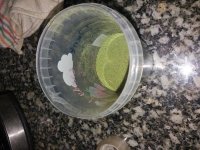-
Happy Birthday ICMag! Been 20 years since Gypsy Nirvana created the forum! We are celebrating with a 4/20 Giveaway and by launching a new Patreon tier called "420club". You can read more here.
-
Important notice: ICMag's T.O.U. has been updated. Please review it here. For your convenience, it is also available in the main forum menu, under 'Quick Links"!
You are using an out of date browser. It may not display this or other websites correctly.
You should upgrade or use an alternative browser.
You should upgrade or use an alternative browser.
Local materials
- Thread starter Microbeman
- Start date
I just make it up as I go.
Like throwing hand grenades
Close is good enough.
Too much is too much.
You can always correct deficiencies.
Too much will cook in your soil while you’re trying to grow.
Too many fine ingredients will plug up your soil.
Too much math. I wing it.
My last mix was just stuff I swept off the storeroom floor.
The plant decides what it wants.
I worry more about porosity. Aeration.
Enter it is an invention to curriculum the values of NPK and know how much to apply to each.
I want to learn to fish not to get the fish, I want to know why the quantities, which is too much or Pi Pi I say in vegetable terms so as not to commit a bullshit.
I thanked him for a link where they teach this or someone can guide me,
I have seen what a super soil recipe is said and follow it, but why of those quantities, that NPK is adequate as amended knowing this you can take any local material or use it properly paste feed your soil.
Thank you.
T
Teddybrae
Wondering ... Rico ... what's the issue for you if Others burn their pasture? Yes, I can imagine loss of some varieties of bacteria ... but the resulting Char should be a greater benefit to you. Seems to me the depletion of pasture by burning is gain for you ...
EDIT: OH. Afterthought. You want the biomass ...
EDIT: OH. Afterthought. You want the biomass ...
Haven't been able to get them to stop burning but I'm working on it
Hookahhead
Active member
Burning is often though of as “good” for the land. However I argue that it’s actually a terrible practice. Aside from the pollution it generates, you’re burning off any nitrogen and phosphorus in that biomass. The only thing that really remains is potassium and heavy metals. The land would be benefit much more from traditional decomposition of that material. Not to mention, the char is easily blown or washed off the now barren land, so there goes the little bit of nutrient that was left behind.
Hookahhead
Active member
I collected more algae this weekend using the same methods as before.
Back to my normal spot, you can see the algae has grown back nicely. Talk about cut and come again greens!
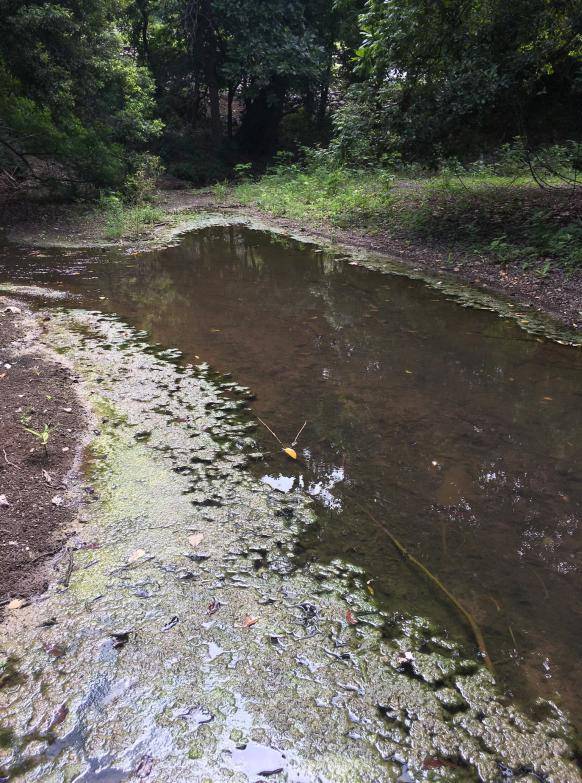
This type algae is known as “hair” algae because it’s very filamentous.
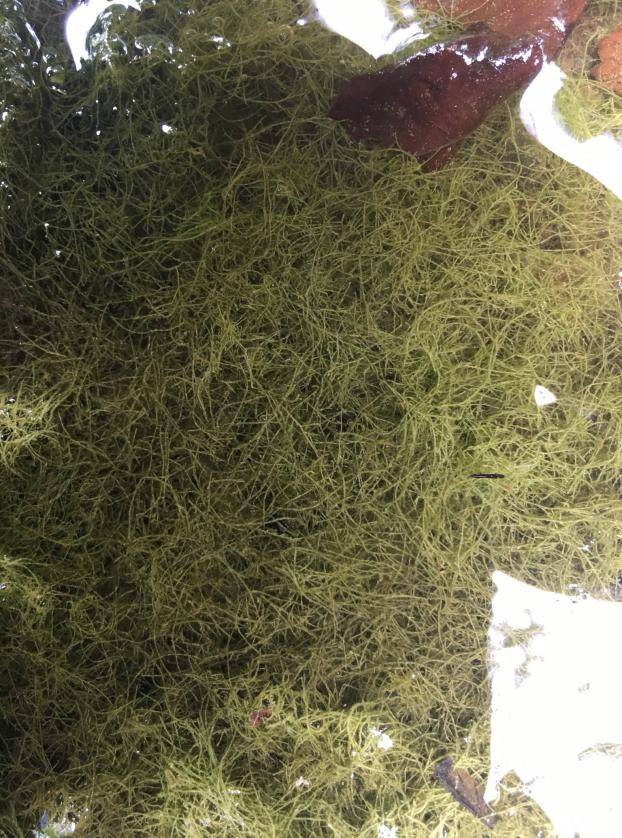
It’s amazing how simple it is just to roll it up in a nice ball.
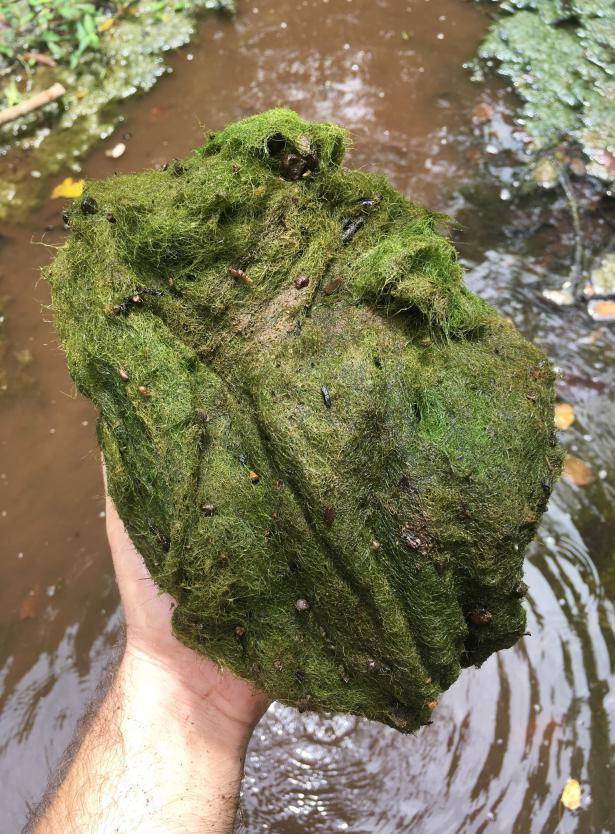
I decided to harvest from both parts of this section. I only harvest the stuff that is easy to collect. Like I’ve said before there is a lot more growing up and down stream if I ever get more adventurous.
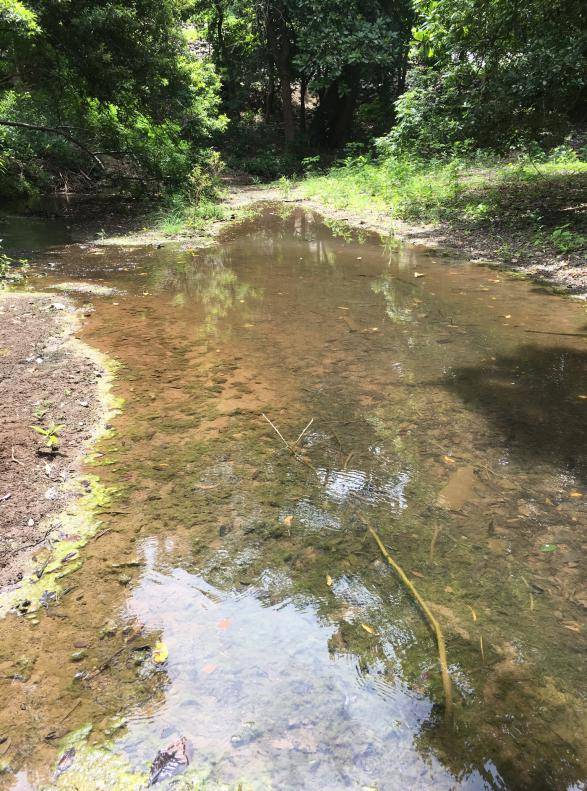
Now I have a nice wheelbarrow load of algae!
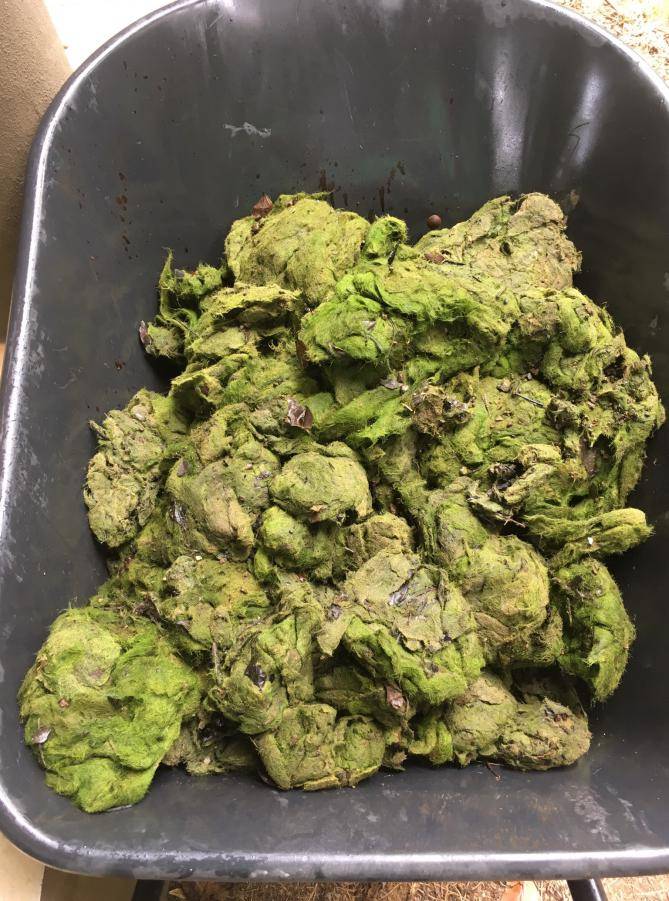
Back to my normal spot, you can see the algae has grown back nicely. Talk about cut and come again greens!
This type algae is known as “hair” algae because it’s very filamentous.
It’s amazing how simple it is just to roll it up in a nice ball.
I decided to harvest from both parts of this section. I only harvest the stuff that is easy to collect. Like I’ve said before there is a lot more growing up and down stream if I ever get more adventurous.
Now I have a nice wheelbarrow load of algae!
Hookahhead
Active member
Now that I have all this algae I need something to do with it.
Recently, I had a few small seedling containers sitting on the surface of some larger pots. When I moved the containers, the roots from the larger plant had grown up to the surface and were now exposed. I’ve known there are many benefits from using a mulch layer, I’ve just never really done it. Seeing the roots at the surface made me decide to change that.
Here is what one of my containers normally looks like.
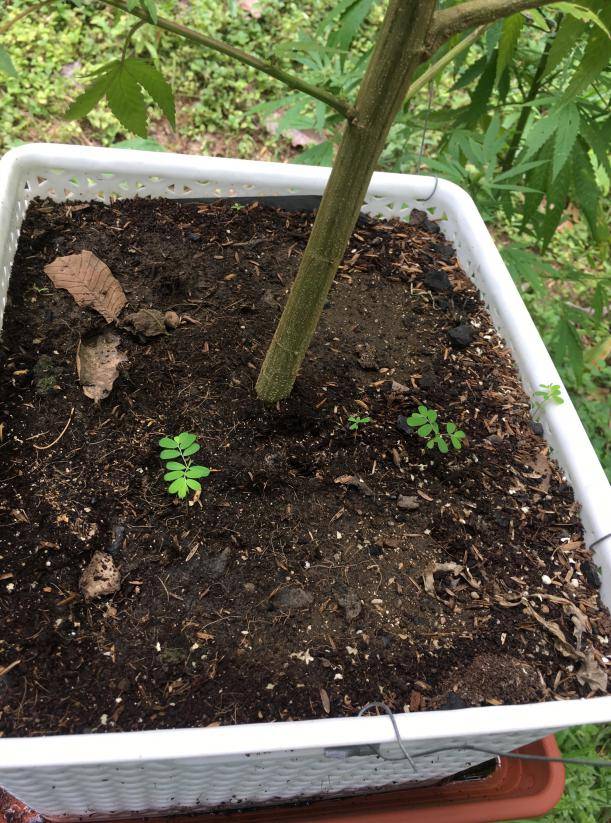
Since the algae is so fibrous, I thought it would make a good mulch. It’s really a nice material to work with, you can tear off pieces and work them in sort of similar to felting wool.
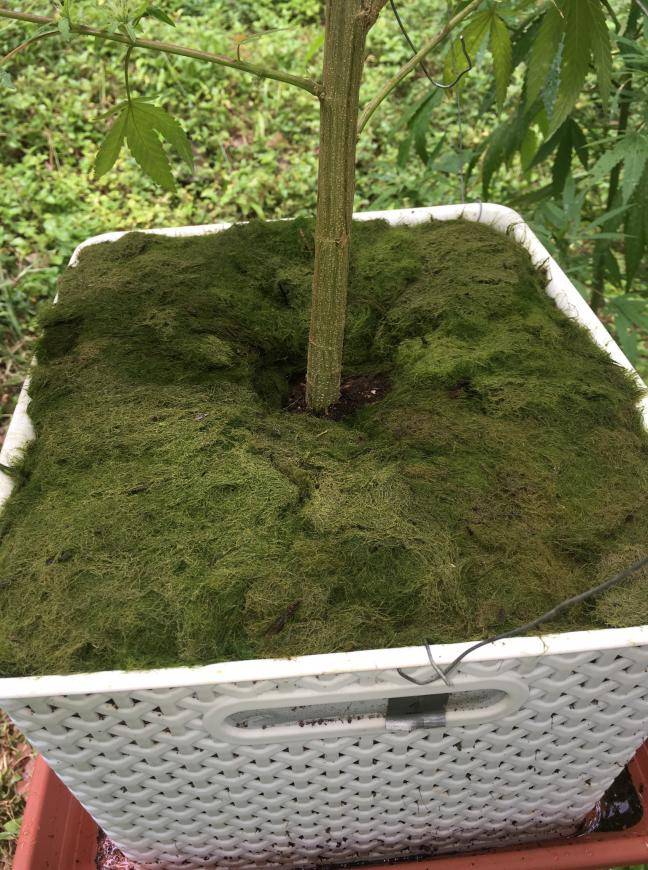
I still had a ton of algae left over after mulching all of my containers. Earlier I posted about trying to LAB ferment the algae, but my dogs tore into the bag and made a huge nasty mess. This time I decided to brew up some “algae wine”, so I pitched some brewers yeast.

Finally I stuffed a 5 gallon plastic carboy full, added the yeast and a rudimentary air lock. I plan to let this ferment for 2-3 weeks, then maybe introduce some acid bacteria to turn the alcohol to vinegar. Then I hope to be able to use that to grow PNSB I am currently experimenting with in this thread.

Recently, I had a few small seedling containers sitting on the surface of some larger pots. When I moved the containers, the roots from the larger plant had grown up to the surface and were now exposed. I’ve known there are many benefits from using a mulch layer, I’ve just never really done it. Seeing the roots at the surface made me decide to change that.
Here is what one of my containers normally looks like.
Since the algae is so fibrous, I thought it would make a good mulch. It’s really a nice material to work with, you can tear off pieces and work them in sort of similar to felting wool.
I still had a ton of algae left over after mulching all of my containers. Earlier I posted about trying to LAB ferment the algae, but my dogs tore into the bag and made a huge nasty mess. This time I decided to brew up some “algae wine”, so I pitched some brewers yeast.
Finally I stuffed a 5 gallon plastic carboy full, added the yeast and a rudimentary air lock. I plan to let this ferment for 2-3 weeks, then maybe introduce some acid bacteria to turn the alcohol to vinegar. Then I hope to be able to use that to grow PNSB I am currently experimenting with in this thread.
mlNow that I have all this algae I need something to do with it.
Recently, I had a few small seedling containers sitting on the surface of some larger pots. When I moved the containers, the roots from the larger plant had grown up to the surface and were now exposed. I’ve known there are many benefits from using a mulch layer, I’ve just never really done it. Seeing the roots at the surface made me decide to change that.
Here is what one of my containers normally looks like.
View Image
Since the algae is so fibrous, I thought it would make a good mulch. It’s really a nice material to work with, you can tear off pieces and work them in sort of similar to felting wool.
View Image
I still had a ton of algae left over after mulching all of my containers. Earlier I posted about trying to LAB ferment the algae, but my dogs tore into the bag and made a huge nasty mess. This time I decided to brew up some “algae wine”, so I pitched some brewers yeast.
View Image
Finally I stuffed a 5 gallon plastic carboy full, added the yeast and a rudimentary air lock. I plan to let this ferment for 2-3 weeks, then maybe introduce some acid bacteria to turn the alcohol to vinegar. Then I hope to be able to use that to grow PNSB I am currently experimenting with in this thread.
View Image
very interesting about the column of Sergei W. but pity. the time it takes .....
Rico Swazi
Active member
Wondering ... Rico ... what's the issue for you if Others burn their pasture? Yes, I can imagine loss of some varieties of bacteria ... but the resulting Char should be a greater benefit to you. Seems to me the depletion of pasture by burning is gain for you ...
EDIT: OH. Afterthought. You want the biomass ...
Hi Teddy, the issue goes far beyond my (very) selfish desire for biomass
trying to save the world from black carbon one burn pile at a time
Abstract
2.2 Black Carbon Emissions and Abundance[1] Black carbon aerosol plays a unique and important role in Earth's climate system. Black carbon is a type of carbonaceous material with a unique combination of physical properties. This assessment provides an evaluation of black‐carbon climate forcing that is comprehensive in its inclusion of all known and relevant processes and that is quantitative in providing best estimates and uncertainties of the main forcing terms: direct solar absorption; influence on liquid, mixed phase, and ice clouds; and deposition on snow and ice. These effects are calculated with climate models, but when possible, they are evaluated with both microphysical measurements and field observations. Predominant sources are combustion related, namely, fossil fuels for transportation, solid fuels for industrial and residential uses, and open burning of biomass. Total global emissions of black carbon using bottom‐up inventory methods are 7500 Gg yr−1 in the year 2000 with an uncertainty range of 2000 to 29000. However, global atmospheric absorption attributable to black carbon is too low in many models and should be increased by a factor of almost 3. After this scaling, the best estimate for the industrial‐era (1750 to 2005) direct radiative forcing of atmospheric black carbon is +0.71 W m−2 with 90% uncertainty bounds of (+0.08, +1.27) W m−2. Total direct forcing by all black carbon sources, without subtracting the preindustrial background, is estimated as +0.88 (+0.17, +1.48) W m−2. Direct radiative forcing alone does not capture important rapid adjustment mechanisms. A framework is described and used for quantifying climate forcings, including rapid adjustments. The best estimate of industrial‐era climate forcing of black carbon through all forcing mechanisms, including clouds and cryosphere forcing, is +1.1 W m−2 with 90% uncertainty bounds of +0.17 to +2.1 W m−2. Thus, there is a very high probability that black carbon emissions, independent of co‐emitted species, have a positive forcing and warm the climate. We estimate that black carbon, with a total climate forcing of +1.1 W m−2, is the second most important human emission in terms of its climate forcing in the present‐day atmosphere; only carbon dioxide is estimated to have a greater forcing. Sources that emit black carbon also emit other short‐lived species that may either cool or warm climate. Climate forcings from co‐emitted species are estimated and used in the framework described herein. When the principal effects of short‐lived co‐emissions, including cooling agents such as sulfur dioxide, are included in net forcing, energy‐related sources (fossil fuel and biofuel) have an industrial‐era climate forcing of +0.22 (−0.50 to +1.08) W m−2 during the first year after emission. For a few of these sources, such as diesel engines and possibly residential biofuels, warming is strong enough that eliminating all short‐lived emissions from these sources would reduce net climate forcing (i.e., produce cooling). When open burning emissions, which emit high levels of organic matter, are included in the total, the best estimate of net industrial‐era climate forcing by all short‐lived species from black‐carbon‐rich sources becomes slightly negative (−0.06 W m−2 with 90% uncertainty bounds of −1.45 to +1.29 W m−2). The uncertainties in net climate forcing from black‐carbon‐rich sources are substantial, largely due to lack of knowledge about cloud interactions with both black carbon and co‐emitted organic carbon. In prioritizing potential black‐carbon mitigation actions, non‐science factors, such as technical feasibility, costs, policy design, and implementation feasibility play important roles. The major sources of black carbon are presently in different stages with regard to the feasibility for near‐term mitigation. This assessment, by evaluating the large number and complexity of the associated physical and radiative processes in black‐carbon climate forcing, sets a baseline from which to improve future climate forcing estimates.
-
.[7] Sources whose emissions are rich in black carbon (“BC‐rich”) can be grouped into a small number of categories, broadly described as diesel engines, industry, residential solid fuel, and open burning. The largest global sources are open burning of forests and savannas. Dominant emitters of black carbon from other types of combustion depend on the location. Residential solid fuels (i.e., coal and biomass) contribute 60 to 80% of Asian and African emissions, while on‐road and off‐road diesel engines contribute about 70% of emissions in Europe, North America, and Latin America. Residential coal is a significant source in China, the former USSR, and a few Eastern European countries. These categories represent about 90% of black‐carbon mass emissions. Other miscellaneous black‐carbon‐rich sources, including emissions from aviation, shipping, and flaring, account for another 9%, with the remaining 1% attributable to sources with very low black carbon emissions
Burning is often though of as “good” for the land. However I argue that it’s actually a terrible practice. Aside from the pollution it generates, you’re burning off any nitrogen and phosphorus in that biomass. The only thing that really remains is potassium and heavy metals. The land would be benefit much more from traditional decomposition of that material. Not to mention, the char is easily blown or washed off the now barren land, so there goes the little bit of nutrient that was left behind.
Oops, sorry I missed this Hookah, very good answer
I live in the Willamette valley known for its grass seed
they burn the fields every year
sucks when it happens
Last edited:
Rico Swazi
Active member
local materials, no till, permaculture, hugelkultur , natural growing , biodynamics, KNF et al,
all are part of the solution in the fight against climate change
getting people to do the work is the challenge
Edit- perhaps getting people to understand the problem is the biggest factor?
take a look at any biochar thread and you will see people advocating open burning
that is the lack of understanding I am referring to
all are part of the solution in the fight against climate change
getting people to do the work is the challenge
Edit- perhaps getting people to understand the problem is the biggest factor?
take a look at any biochar thread and you will see people advocating open burning
that is the lack of understanding I am referring to
Last edited:
T
Teddybrae
OFF THREAD!
(Rico ... part of the problem is fragmentation of thought: first I want to have an organic garden because it is an environmentally sound practice. Then I want to fly to Amsterdam to go to a cannabis fest. Dig what I mean?)
(Rico ... part of the problem is fragmentation of thought: first I want to have an organic garden because it is an environmentally sound practice. Then I want to fly to Amsterdam to go to a cannabis fest. Dig what I mean?)
Rico Swazi
Active member
not really, but I was hoping not to offend you or anyone else by my comments
Grass seed is a huge crop here in the Willamette valley
every year, 15,000 acres of soot goes into the air
its an issue near and dear to me because I'm right in the middle of it
https://www.oregon.gov/deq/aq/Pages/Burning-Willamette.aspx
I have a fear of flying otherwise I would join you and buy the first round!
Grass seed is a huge crop here in the Willamette valley
every year, 15,000 acres of soot goes into the air
its an issue near and dear to me because I'm right in the middle of it
https://www.oregon.gov/deq/aq/Pages/Burning-Willamette.aspx
I have a fear of flying otherwise I would join you and buy the first round!
not really, but I was hoping not to offend you or anyone else by my comments
Grass seed is a huge crop here in the Willamette valley
every year, 15,000 acres of soot goes into the air
its an issue near and dear to me because I'm right in the middle of it
https://www.oregon.gov/deq/aq/Pages/Burning-Willamette.aspx
I have a fear of flying otherwise I would join you and buy the first round!
I might be confused. I thought Teddy was waxing sarcastic....maybe Rico is too?
The man lived within nature
his maturity despised by others
Empathy emboldened mistaken for lunacy
his maturity despised by others
Empathy emboldened mistaken for lunacy
Rico Swazi
Active member
I might be confused. I thought Teddy was waxing sarcastic....maybe Rico is too?
Rico confused frustrated and sarcastic ? most likely
Sorry for any ill feelings? most Definitely
my epitaph?The man lived within nature
his maturity despised by others
Empathy emboldened mistaken for lunacy
swap maturity for big mouth and it fits
Rico Swazi
Active member
They’ll build a Walmart in my front yard when I die.
they paved paradise and put up a (walmart) parking lot-Joni
they paved paradise and put up a (walmart) parking lot-Joni
fuckin Canadian eh?
Oh Canada
I could drink a case of you
And I'd still be on my feet ~ Joni
https://www.youtube.com/watch?v=f_OtHVLAF4o
We can share the epitaph - Teddy, hh? mass grave? International wake?
I could drink a case of you
And I'd still be on my feet ~ Joni
https://www.youtube.com/watch?v=f_OtHVLAF4o
We can share the epitaph - Teddy, hh? mass grave? International wake?

